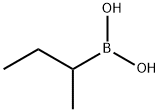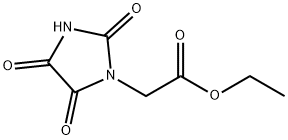PARABANIC ACID
Synonym(s):Imidazolidinetrione;Oxalylurea;Trioxoimidazolidine
- CAS NO.:120-89-8
- Empirical Formula: C3H2N2O3
- Molecular Weight: 114.06
- MDL number: MFCD00014493
- EINECS: 204-434-3
- SAFETY DATA SHEET (SDS)
- Update Date: 2023-06-08 17:06:37

What is PARABANIC ACID?
Chemical properties
White Crystalline Solid
The Uses of PARABANIC ACID
Parabanic acid appears to be an important marker of free radical reactions in vivo and may be used to monitor free radical activity and to evaluate pharmacological therapy with radical scavengers.
The Uses of PARABANIC ACID
A useful synthetic intermediate
The Uses of PARABANIC ACID
Reactant for:• ;Enantiospecific assembly of homochiral, hexanuclear palladium complexes1• ;Mitsunobu reactions2• ;Quantitative cascade condensation reactions3Reactant for synthesis of:• ;Pyridine derivatives4• ;Nitroesters5• ;Parabanic acid derivatives6
Definition
ChEBI: An imidazolidinone that is imidazolidine which is substituted by oxo groups at positions 2, 4 and 5.
Properties of PARABANIC ACID
| Melting point: | 249 °C (dec.) (lit.) |
| Boiling point: | 213.51°C (rough estimate) |
| Density | 1.7674 (rough estimate) |
| refractive index | 1.4700 (estimate) |
| storage temp. | Sealed in dry,Room Temperature |
| solubility | DMSO (Slightly), Ethyl Acetate (Slightly, Heated) |
| form | Solid |
| pka | pK1:6.1 (25°C) |
| color | White |
| Water Solubility | almost transparency |
| Merck | 14,7022 |
| CAS DataBase Reference | 120-89-8(CAS DataBase Reference) |
| EPA Substance Registry System | Imidazolidinetrione (120-89-8) |
Safety information for PARABANIC ACID
| Signal word | Warning |
| Pictogram(s) |
 Exclamation Mark Irritant GHS07 |
| GHS Hazard Statements |
H315:Skin corrosion/irritation H319:Serious eye damage/eye irritation H335:Specific target organ toxicity, single exposure;Respiratory tract irritation |
| Precautionary Statement Codes |
P261:Avoid breathing dust/fume/gas/mist/vapours/spray. P264:Wash hands thoroughly after handling. P264:Wash skin thouroughly after handling. P271:Use only outdoors or in a well-ventilated area. P280:Wear protective gloves/protective clothing/eye protection/face protection. P302+P352:IF ON SKIN: wash with plenty of soap and water. P305+P351+P338:IF IN EYES: Rinse cautiously with water for several minutes. Remove contact lenses, if present and easy to do. Continuerinsing. |
Computed Descriptors for PARABANIC ACID
| InChIKey | ZFLIKDUSUDBGCD-UHFFFAOYSA-N |
New Products
4-Aminotetrahydropyran-4-carbonitrile Hydrochloride (R)-3-Aminobutanenitrile Hydrochloride 4-AMINO-TETRAHYDRO-PYRAN-4-CARBOXYLIC ACID HCL 4-(Dimethylamino)tetrahydro-2H-pyran-4-carbonitrile 3-((Dimethylamino)methyl)-5-methylhexan-2-one oxalate 1,4-Dioxa-8-azaspiro[4.5]decane 5-Bromo-2-nitropyridine Nimesulide BP Aceclofenac IP/BP/EP Mefenamic Acid IP/BP/EP/USP Diclofenac Sodium IP/BP/EP/USP Ornidazole IP Diclofenac Potassium SODIUM AAS SOLUTION ZINC AAS SOLUTION BUFFER SOLUTION PH 10.0(BORATE) GOOCH CRUCIBLE SINTERED AQUANIL 5 BERYLLIUM AAS SOLUTION 2-Bromo-1-(bromomethyl)-3-chloro-5-nitrobenzene 2-Bromo-3-nitroaniline N-(3-Hydroxypropyl)-N-methylacetamide 3-Bromo-6-chloropyridazine 4-ethyl-3-nitrobenzoic acidRelated products of tetrahydrofuran






![1-[4-(4-CHLOROPHENOXY)PHENYL]-3-[(2,6-DICHLORO-4-METHYL-3-PYRIDYL)CARBONYL]IMIDAZOLIDINE-2,4,5-TRIONE](https://img.chemicalbook.in/StructureFile/ChemBookStructure2/GIF/CB1342666.gif)
![1-(2-METHYLBENZYL)-3-[3-(TRIFLUOROMETHYL)BENZYL]-1H-IMIDAZOLE-2,4,5(3H)-TRIONE](https://img.chemicalbook.in/StructureFile/ChemBookStructure4/GIF/CB0760182.gif)
You may like
-
 Parabanic Acid CAS 120-89-8View Details
Parabanic Acid CAS 120-89-8View Details
120-89-8 -
 Parabanic acid 95% CAS 120-89-8View Details
Parabanic acid 95% CAS 120-89-8View Details
120-89-8 -
 1823368-42-8 98%View Details
1823368-42-8 98%View Details
1823368-42-8 -
 2-(3-(tert-butyl)phenoxy)-2-methylpropanoic acid 1307449-08-6 98%View Details
2-(3-(tert-butyl)phenoxy)-2-methylpropanoic acid 1307449-08-6 98%View Details
1307449-08-6 -
 Ethyl 3-(furan-2-yl)-3-hydroxypropanoate 25408-95-1 98%View Details
Ethyl 3-(furan-2-yl)-3-hydroxypropanoate 25408-95-1 98%View Details
25408-95-1 -
 2-Chloro-5-fluoro-1-methoxy-3-methylbenzene 98%View Details
2-Chloro-5-fluoro-1-methoxy-3-methylbenzene 98%View Details
1805639-70-6 -
 1784294-80-9 98%View Details
1784294-80-9 98%View Details
1784294-80-9 -
 Lithium ClavulanateView Details
Lithium ClavulanateView Details
61177-44-4
Statement: All products displayed on this website are only used for non medical purposes such as industrial applications or scientific research, and cannot be used for clinical diagnosis or treatment of humans or animals. They are not medicinal or edible.